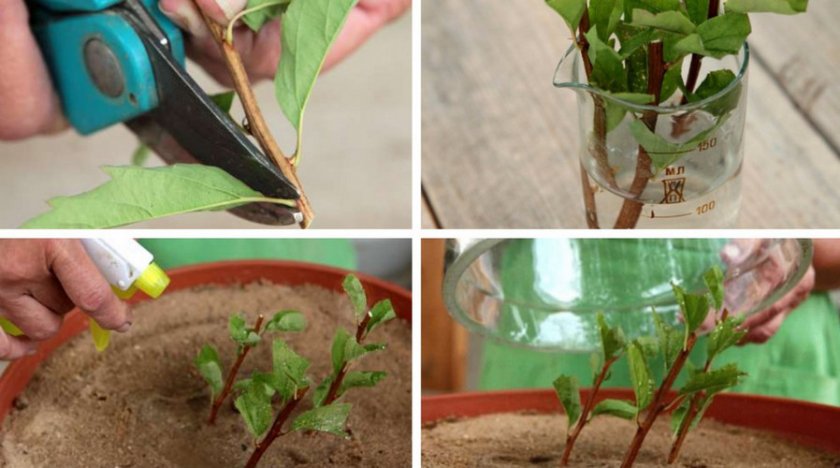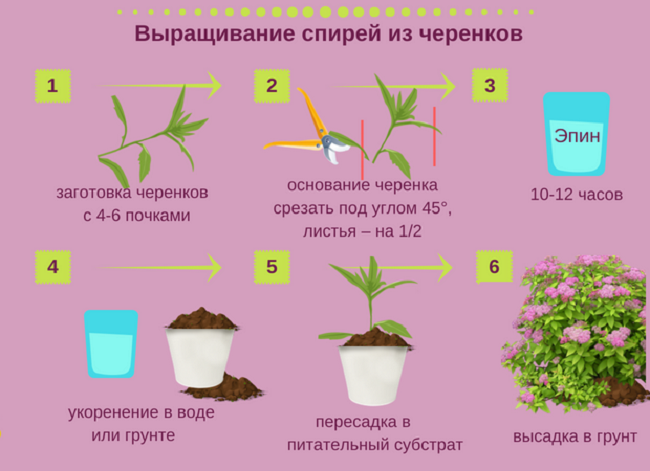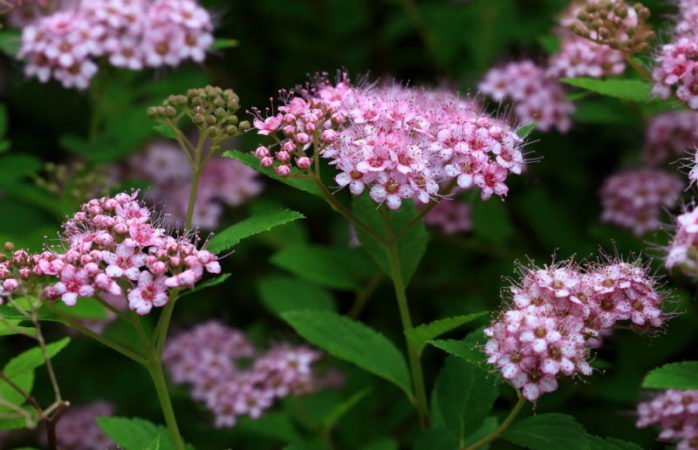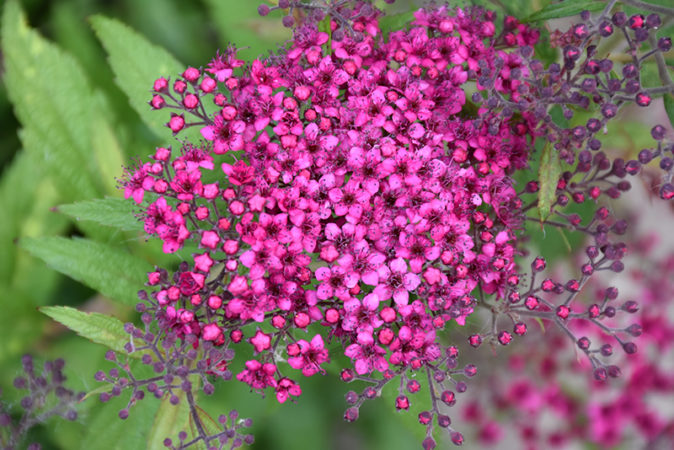Reproduction of spirea by cuttings in the summer for beginners: rooting methods and further actions
Spirea is an unpretentious and spectacular ornamental shrub. It is propagated both by seeds and vegetatively. Breeding with cuttings is the simplest method that even a novice gardener will successfully master. Consider how to properly propagate spirea by cuttings in the summer.
The content of the article
Is it possible to propagate spirea by cuttings in summer
Vegetative breeding of spirea is the simplest, and therefore the most common method. Cuttings are carried out with equal success throughout the growing season: from spring to autumn.
Some gardeners perform the procedure in the summer starting in July, citing the following benefits:
- the ability to immediately prepare planting material, since by this time the active growth of greenery on plants blooming in spring ends, and the cuttings remain green and semi-lignified;
- rooting before the onset of cold weather;
- plant survival - 70%.
Summer cuttings can be associated with certain difficulties caused by the peculiarities of the weather. So, you often have to wait so that it is not too hot and dry. Otherwise, there is a risk that the stalk will not take root.

Timing
Some types of spirits, for example, Japanese, are cut in June. Most of the others are from July. Regardless of the month and plant variety, cool, cloudy and even rainy days are most favorable for cuttings.
Selection and preparation of cuttings
For the propagation of spirea by cuttings in the summer, both annual, semi-lignified, and young, green cuttings are harvested.
Planting material is cut from healthy bushes that do not have visual signs of pest or disease damage. Sections are made with a sharp knife at an angle of 30 °. The top of the selected shoot is cut at a right angle.
Important! Among the young shoots of the current year, those on which flowering have already stopped are chosen.
Future cuttings are shoots 11-15 cm long, with 2 pairs of green leaves or buds. For rooting, cut branches are placed in a solution that stimulates the formation of roots: "Kornevin", "Epin" or "Heteroauxin".
For rooting to proceed faster, it is recommended to completely remove the 2 lower leaves on each cutting, and shorten the remaining upper ones by half.
After the formation of the roots, the cuttings are transferred into separate containers filled with a loose substrate, consisting of a mixture of wet sand and peat. The shoots are planted to a depth of 3 cm at an angle of 45 °, sprayed with water and covered with plastic wrap, forming a mini-greenhouse. The seedlings are periodically ventilated and moistened by spraying, preventing the soil from drying out.
After 3 weeks after the start of rooting, the plants are freed from the shelter and kept for another 14 days, regularly watering. When the seedlings are fully grown, they are transplanted to a permanent place in the open ground.

Planting ready-made cuttings
The transplant of ready-made cuttings, harvested and rooted in the summer, is carried out in mid-autumn. To do this, choose a flat, well-lit plot of land, protected from drafts, with loose fertile soil.
Planting holes are prepared, the width and depth of which is 3 and 1.5 times, respectively, the size of the root system of the seedling.
Reference. The distance between the planting holes is 40–70 cm.
The plant is placed in a hole, the roots are gently straightened and covered with a mixture of garden soil, peat and sand (1: 1: 1).The seedlings are watered and the soil around them is mulched.
Features of cuttings depending on the region and variety
The timing of grafting and planting seedlings in open ground is determined by the climatic characteristics of the region. So, in the middle lane, work is carried out in early spring if the cuttings were harvested and rooted last fall, as well as in autumn, if rooting took place in the summer.
In colder regions, spring planting is preferred.
Reference. How to plant a spirea by dividing a bush? To do this, choose cloudy weather, dig out a bush, wash off the soil from the roots and cut the plant into 2-3 parts. Each should have enough roots and some strong shoots. The roots are trimmed with pruning shears. The plots are transplanted into holes, watered regularly and abundantly so that the soil is not dry.
Some crop varieties have their own characteristics of cuttings. So, gray spirea, Japanese and Goldflame, which are early flowering, are propagated in summer by green cuttings, when the shoots of the current year become semi-lignified.
The harvested cuttings take root by the onset of autumn and can be planted in open ground in the same year.
Further care

Subsequent care for the planted young plants consists in watering, loosening and mulching the soil, fertilizing, pruning, and combating diseases and pests.
Spireas need regular watering. So, in a dry period, up to 15 liters of water is required for each bush twice a month.
Attention! Japanese spiraea is especially vulnerable to a lack of moisture. During prolonged drought, the risk of plant death from lack of moisture increases.
It is recommended to loosen the soil after each watering so that the soil does not compact. Mulching the soil with organic materials, such as sawdust, peat, husks from seeds, nuts or buckwheat, will help to avoid this and retain moisture in the substrate. The thickness of the mulching layer should be between 6 and 8 cm.
For full development and abundant flowering, spireas are fed in early spring with a complex preparation, for example, "Kemira Lux"... The varieties blooming from July to August are additionally fertilized in June.
Plants that have reached the age of more than 7 years are carried out spring formative pruning, removing the weakened and shortening the shoots that have started to grow strongly.
Experienced gardening tips

Growing spirea from a cutting does not cause any particular difficulties. However, there are some points, the knowledge of which greatly facilitates the reproduction and cultivation of a shrub:
- Summer cuttings with semi-lignified shoots are carried out in the second half of summer.
- Suitable for cuttings are straight shoots from 10 to 15 cm long, which bear at least 4 buds.
- When planting a cutting, the angle of inclination of 45 ° must be taken into account. This makes rooting better.
- Dip the lower cut of the shoot in dry "Kornevin" or "Heteroauxin" promotes early engraftment.
- Rooting lasts at least a month, during which the cuttings are provided with a warm, moist environment, covering it with a film or a cut plastic bottle.
- It is better to plant a spirea in a sunny area. Partial shade is bad for the splendor of flowering.
- Maintaining the required moisture level in containers with cuttings is facilitated by regular spraying of plants and the soil under them.
It is interesting:
How to care for a home potted rose - a beginner's guide
A guide to cutting roses in the fall at home for beginner florists
Simple ways to save rose cuttings until spring and plant them correctly
How to propagate a climbing rose by cuttings in the summer in stages
What is petunia pruning in mid-summer for and how to carry it out correctly
Conclusion
Cuttings are the most productive way to reproduce spirea. For this, both semi-lignified and young green shoots are used.
After rooting in separate containers in a mini-greenhouse, the plants are planted in open ground in mid-autumn or next spring. Caring for them includes a set of standard procedures: watering, loosening, feeding and pruning.